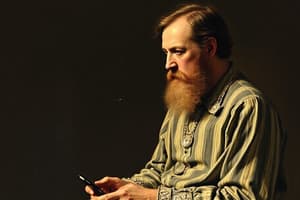Podcast
Questions and Answers
What program did Tim Berners-Lee develop in 1980 that laid the groundwork for a connected document system?
What program did Tim Berners-Lee develop in 1980 that laid the groundwork for a connected document system?
- CERNET
- ENQUIRE (correct)
- HTML
- HTTP
In what year did Tim Berners-Lee propose his concept for a linked hypertext data system?
In what year did Tim Berners-Lee propose his concept for a linked hypertext data system?
- 1989 (correct)
- 1980
- 1991
- 1985
Which of the following elements did not form part of the initial launch of the World Wide Web in 1991?
Which of the following elements did not form part of the initial launch of the World Wide Web in 1991?
- HTML
- First web browser
- WWW Protocol (correct)
- HTTP
What was the major influence behind Berners-Lee's invention of the World Wide Web?
What was the major influence behind Berners-Lee's invention of the World Wide Web?
What honor did Tim Berners-Lee receive in 2004 for his contributions to the internet?
What honor did Tim Berners-Lee receive in 2004 for his contributions to the internet?
What was the primary intention behind Tim Berners-Lee's creation of the World Wide Web?
What was the primary intention behind Tim Berners-Lee's creation of the World Wide Web?
Which of the following statements regarding the standards upon which the web was built is accurate?
Which of the following statements regarding the standards upon which the web was built is accurate?
Which significant event occurred on April 30, 1991, in relation to the World Wide Web?
Which significant event occurred on April 30, 1991, in relation to the World Wide Web?
How did the decision not to patent the World Wide Web impact its development?
How did the decision not to patent the World Wide Web impact its development?
What role did the World Wide Web Consortium (W3C) play in the evolution of the web?
What role did the World Wide Web Consortium (W3C) play in the evolution of the web?
Who was J.C.R. Licklider and what was his contribution to computer technology?
Who was J.C.R. Licklider and what was his contribution to computer technology?
What impact did the simplicity of HTML and HTTP have on the adoption of the web?
What impact did the simplicity of HTML and HTTP have on the adoption of the web?
What was a notable feature of the first webpage published?
What was a notable feature of the first webpage published?
Flashcards
HTML
HTML
A markup language used to create web pages by defining the structure and content of web documents. It defines elements, headings, images, and more, making web pages readable by humans and computers.
HTTP
HTTP
The protocol responsible for sending and receiving information between web servers and web browsers, allowing communication and data exchange on the internet.
ENQUIRE
ENQUIRE
An early program created by Tim Berners-Lee to manage information and track connections within CERN. It served as a precursor to the World Wide Web concept.
World Wide Web
World Wide Web
Signup and view all the flashcards
Tim Berners-Lee
Tim Berners-Lee
Signup and view all the flashcards
The Web's Open Access
The Web's Open Access
Signup and view all the flashcards
What is HTML?
What is HTML?
Signup and view all the flashcards
What is HTTP?
What is HTTP?
Signup and view all the flashcards
Why did the Web grow so fast?
Why did the Web grow so fast?
Signup and view all the flashcards
Who is J.C.R. Licklider?
Who is J.C.R. Licklider?
Signup and view all the flashcards
Why was the World Wide Web free?
Why was the World Wide Web free?
Signup and view all the flashcards
What is the W3C?
What is the W3C?
Signup and view all the flashcards
How did the Web change the world?
How did the Web change the world?
Signup and view all the flashcards
Study Notes
Tim Berners-Lee: Inventor of the World Wide Web
- Born in London, 1955, interested in computers from a young age
- Worked on early computers like the Mark I
- Studied physics at Oxford University
- Built a home-made computer in the 1970s
- Joined CERN in 1980 as a consultant.
- Faced communication challenges at CERN due to multilingual staff.
- Created ENQUIRE (1980): a program to store information and track connections at CERN (only on his computer)
- ENQUIRE demonstrated the potential of interlinked documents
- Developed World Wide Web (1991) – HTML, HTTP, and the first browser.
- Made the Web publicly available, choosing not to receive royalties
- Knighted in 2004 for his role in developing the internet.
- His vision: universal access to a vast network of documents, democratic and open, benefiting everyone
Studying That Suits You
Use AI to generate personalized quizzes and flashcards to suit your learning preferences.





